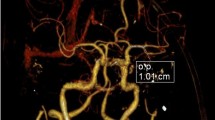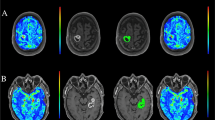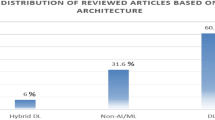Abstract
Purpose
To compare the diagnostic performance of 1.5 T versus 3 T magnetic resonance angiography (MRA) for detecting cerebral aneurysms with clinically available deep learning-based computer-assisted detection software (EIRL aneurysm® [EIRL_an]), which has been approved by the Japanese Pharmaceuticals and Medical Devices Agency. We also sought to analyze the causes of potential false positives.
Methods
In this single-center, retrospective study, we evaluated the MRA scans of 90 patients who underwent head MRA (1.5 T and 3 T in 45 patients each) in clinical practice. Overall, 51 patients had 70 aneurysms. We used MRI from a vendor not included in the dataset used to create the EIRL_an algorithm. Two radiologists determined the ground truth, the accuracy of the candidates noted by EIRL_an, and the causes of false positives. The sensitivity, number of false positives per case (FPs/case), and the causes of false positives were compared between 1.5 T and 3 T MRA. Pearson’s χ2 test, Fisher’s exact test, and the Mann‒Whitney U test were used for the statistical analyses as appropriate.
Results
The sensitivity was high for 1.5 T and 3 T MRA (0.875‒1), but the number of FPs/case was significantly higher with 3 T MRA (1.511 vs. 2.578, p < 0.001). The most common causes of false positives (descending order) were the origin/bifurcation of vessels/branches, flow-related artifacts, and atherosclerosis and were similar between 1.5 T and 3 T MRA.
Conclusion
EIRL_an detected significantly more false-positive lesions with 3 T than with 1.5 T MRA in this external validation study. Our data may help physicians with limited experience with MRA to correctly diagnose aneurysms using EIRL_an.






Similar content being viewed by others
Abbreviations
- 3D:
-
Three-dimensional
- ACA:
-
Anterior cerebral artery
- AI:
-
Artificial intelligence
- ARSS:
-
Abierto Reading Support Solution
- CAD:
-
Computer-assisted detection
- CNN:
-
Convolutional neural network
- EIRL_an:
-
EIRL aneurysm
- FOV:
-
Field of view
- FPs/case:
-
False positives per case
- ICA:
-
Internal carotid artery
- MCA:
-
Middle cerebral artery
- MIP:
-
Maximum intensity projection
- MRA:
-
Magnetic resonance angiography
- MRI:
-
Magnetic resonance imaging
- PMDA:
-
Pharmaceuticals and Medical Devices Agency
- TE:
-
Echo time
- TOF:
-
Time-of-flight
- TR:
-
Repetition time
- SAH:
-
Subarachnoid hemorrhage
References
Ajiboye N, Chalouhi N, Starke RM et al (2015) Unruptured cerebral aneurysms: evaluation and management. Sci World J 2015:954954
Macdonald RL, Schweizer TA (2017) Spontaneous subarachnoid haemorrhage. Lancet 389:655–666
Rinkel GJE, Algra A (2011) Long-term outcomes of patients with aneurysmal subarachnoid haemorrhage. Lancet Neurol 10:349–356
Sailer AMH, Wagemans BAJM, Nelemans PJ et al (2014) Diagnosing intracranial aneurysms with MR angiography: systematic review and meta-analysis. Stroke 45:119–126
Okahara M, Kiyosue H, Yamashita M et al (2002) Diagnostic accuracy of magnetic resonance angiography for cerebral aneurysms in correlation with 3D-digital subtraction angiographic images: a study of 133 aneurysms. Stroke 33:1803–1808
Din M, Agarwal S, Grzeda M et al (2023) Detection of cerebral aneurysms using artificial intelligence: a systematic review and meta-analysis. J Neurointerv Surg 15:262–271
Shi Z, Hu B, Schoepf UJ et al (2020) Artificial intelligence in the management of intracranial aneurysms: current status and future perspectives. AJNR Am J Neuroradiol 41:373–379
Claux F, Baudouin M, Bogey C, Rouchaud A (2023) Dense, deep learning-based intracranial aneurysm detection on TOF MRI using two-stage regularized U-Net. J Neuroradiol 50:9–15
Lei X, Yang Y (2022) Deep learning-based magnetic resonance imaging in diagnosis and treatment of intracranial aneurysm. Comput Math Methods Med 2022:1683475
Terasaki Y, Yokota H, Tashiro K et al (2021) Multidimensional deep learning reduces false-positives in the automated detection of cerebral aneurysms on time-of-flight magnetic resonance angiography: a multi-center study. Front Neurol 12:742126
Ishihara M, Shiiba M, Maruno H et al (2023) Detection of intracranial aneurysms using deep learning-based CAD system: usefulness of the scores of CNN’s final layer for distinguishing between aneurysm and infundibular dilatation. Jpn J Radiol 41:131–141
Nakao T, Hanaoka S, Nomura Y et al (2018) Deep neural network-based computer-assisted detection of cerebral aneurysms in MR angiography. J Magn Reson Imaging 47:948–953
Tajima T, Akai H, Yasaka K et al (2023) Usefulness of deep learning-based noise reduction for 1.5 T MRI brain images. Clin Radiol 78:e13–e21
Ueda D, Yamamoto A, Nishimori M et al (2019) Deep learning for MR angiography: automated detection of cerebral aneurysms. Radiology 290:187–194
Hayashi N, Masutani Y, Masumoto T et al (2003) Feasibility of a curvature-based enhanced display system for detecting cerebral aneurysms in MR angiography. Magn Reson Med Sci 2:29–36
Runge VM, Heverhagen JT (2022) The clinical utility of magnetic resonance imaging according to field strength, specifically addressing the breadth of current state-of-the-art systems, which include 0.55 T, 1.5 T, 3 T, and 7 T. Invest Radiol 57:1–12
Yoon NK, McNally S, Taussky P, Park MS (2016) Imaging of cerebral aneurysms: a clinical perspective. Neurovasc Imaging 2:1–7
Gibbs GF, Huston J, Bernstein MA et al (2004) Improved image quality of intracranial aneurysms: 3.0-T versus 1.5-T time-of-flight MR angiography. AJNR Am J Neuroradiol 25:84–87
Ozsarlak O, Van Goethem JW, Maes M, Parizel PM (2004) MR angiography of the intracranial vessels: technical aspects and clinical applications. Neuroradiology 46:955–972
Funding
This study was technically and financially supported by Canon Medical Systems Corporation. Any data and information included in this study were not controlled by Canon Medical Systems Corporation.
Author information
Authors and Affiliations
Corresponding author
Ethics declarations
Conflict of interest
The author declares a conflict of interest: Shigeru Kiryu got research grants from Canon Medical Systems Corporation.
Ethical approval
This retrospective study of MRI data analysis using AI was approved by our Institutional Review Board (approval no. 20-Nr-056).
Informed consent
Written informed consent was waived by the Institutional Review Board.
Additional information
Publisher's Note
Springer Nature remains neutral with regard to jurisdictional claims in published maps and institutional affiliations.
Rights and permissions
Springer Nature or its licensor (e.g. a society or other partner) holds exclusive rights to this article under a publishing agreement with the author(s) or other rightsholder(s); author self-archiving of the accepted manuscript version of this article is solely governed by the terms of such publishing agreement and applicable law.
About this article
Cite this article
Tajima, T., Akai, H., Yasaka, K. et al. Comparison of 1.5 T and 3 T magnetic resonance angiography for detecting cerebral aneurysms using deep learning-based computer-assisted detection software. Neuroradiology 65, 1473–1482 (2023). https://doi.org/10.1007/s00234-023-03216-8
Received:
Accepted:
Published:
Issue Date:
DOI: https://doi.org/10.1007/s00234-023-03216-8




